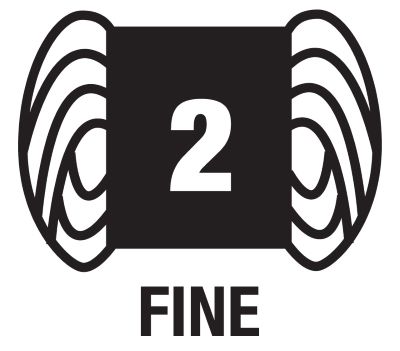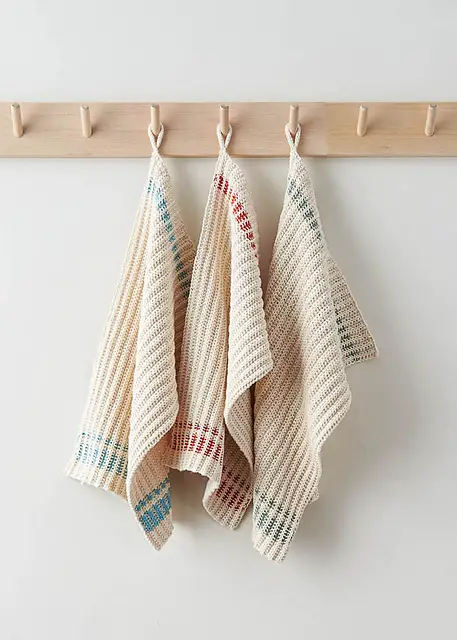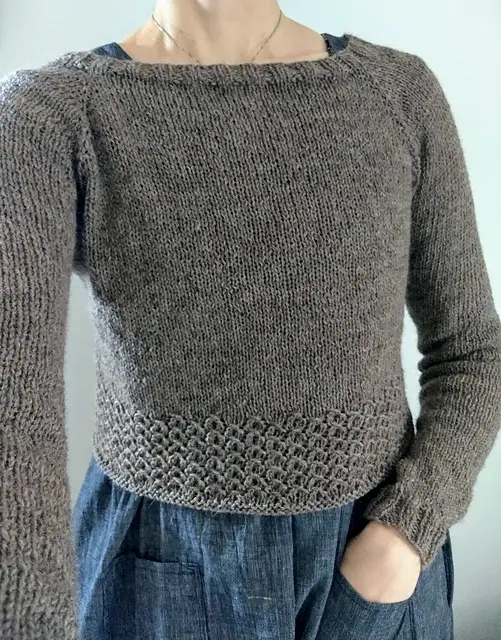When I first heard the term “sport weight yarn,” I thought it was unusual. Knitting is not a sport and has nothing to do with sports. I looked more into the term, and “sport” is short for “sportswear” in this context. I wanted to learn more about the yarn weight, and this is what I found.
Fine weight yarn, more commonly known as sport weight, refers to a thin piece of yarn. It’s slightly thicker than super fine yarn, but still has a small enough gauge to create a lightweight, sturdy fabric. It’s good for colorwork designs, lace, garments and accessories.
I understand the difficulty of choosing yarn that pairs well with patterns. Color and feel are not always the best methods for picking yarn. I’ve learned that yarn weight plays an important role in the project too because it affects the look. Take a look at the pictures for example. The lightweight towels and sweater would not look that way if any other yarn weight were used. Snag the free patterns through the links: Farmhouse Dishtowels by Purl Soho and Winter Garden Sweater by Hook Mountain Handmade.
I covered Lace Weight and Super Fine weight yarn in previous posts. In this post, I would like to cover fine weight yarn and what the industry means by sport weight yarn. Please join me in diving deeper into yarn weights!
Fine Weight Yarn Standards
The Craft Yarn Council (CYC) created a standard yarn weight system for the US. It is based on a number system that starts from 0, the thinnest, and goes up to 7, the thickest. Fine weight yarn is what the CYC considers a 2. Besides the numbering system, the CYC also gives guidelines for gauge and hook/needle sizes for fine weight yarn.
CYC Gauge and Tool Recommendations
Gauge, hook and needle suggestions for knit and crochet are printed on the labels. These are based on the testing done by the yarn manufacturers.
But the CYC put a set of guidelines for everyone (in the US) to use, which is listed below. The information is based off of the CYC website and you can access that here for more details.
| | Standard CYC Gauge* | CYC Recommended Tool Size |
| Knit | 23 – 26 sts stockinette | 3.25 – 3.75mm, 3 – 5(US) needles |
| Crochet | 16 – 20 sts sc | 3.25 – 4.5mm, E-4 – 7(US) hook |
Ravelry (an online database for crochet and knitting patterns) also provides a guideline for knit gauge. According to them, you should get 24-26 stitches per 4 inches (10 cm). You can see that this is in align with what the CYC says.
Remember though, these are not exact. The gauge and hook/needle size provide you with a strong baseline, but you should always do your own testing.
Wraps Per Inch
Wraps per inch (WPI) is useful for yarn weights if you ever lose your labels. Measuring WPI is super simple. The CYC has more detailed information on their website here. But basically you wrap yarn around a pencil. Then you measure an inch and count how many wraps are in that inch. Finally, you compare to the CYC standards for WPI to know what the yarn weight is.
The CYC states that fine weight (1) should have 12-18 wraps per inch. Unfortunately, at this time I don’t have any fine weight yarn on hand to compare my numbers to, so I used other reputable sources, Bluprint and Ravelry.
Bluprint says that sport weight yarn is 15-18 WPI, which is a smaller margin, but still in alignment with the CYC. You can access the Bluprint article here. Ravelry states that fine weight yarn should be 12 WPI according to their yarn weight standards page.
Other Common Terms for Fine Weight Yarn
As I mentioned previously, the CYC created the yarn weight system for the US. Fine weight is equivalent to a 2 according to their standards. But not everyone in the world uses the same terminology. I summarized the most common terms used for lace weight yarn below, and I will go into more detail about each.

Also Known As
- Fine – 2
- Sport
- Baby
- 4-ply
- 5-ply
In the US, and other countries, fine weight yarn is also commonly called sport and baby yarn.
- Fine – 2. This is how the Craft Yarn Council refers to the light weight yarn. The symbol above is what is printed on yarn labels in the US so that you can easily identify the yarn weight.
- Sport yarn. Originally, fine weight yarn was the preferable choice for sportswear clothing. And the name just stuck. Now the yarn weight is used for so much more.
- Baby yarn. I said this in the Super Fine weight article, but I’ll repeat it again. I think “baby” yarn is a broad term. There are yarns marketed for babies in all different yarn weight categories. However, I believe super fine and fine weight yarns are also called baby yarn because it is a popular yarn weight to make lightweight baby garments and accessories.
The UK, Australia and New Zealand tend to refer to yarn weights by plies. The lower the ply count, the thinner the yarn. Although, don’t confuse this with how many plies the yarn is actually composed of. Ply count used to refer to the number of strands in the yarn, but modern processes have changed that. Now the term ply simply means the thickness of the yarn, when referring to yarn weights.
I looked at several sources to hopefully give the most accurate information, as I live in the US and don’t use this notation for yarn weights. This is what I found.
- 4-ply. In the UK, sport weight yarn is commonly referred to as 4-ply yarn.
- 5-ply. Ravelry lists 5-ply as the UK, NZ, and AU term for fine weight yarn. According to a couple of other sources that I found, only Australia and New Zealand use the term 5-ply to mean fine weight.
If you live in one of the areas that uses ply to determine yarn weight, please let me know if I should update this section!
Important Properties of Fine Weight Yarn
Fine weight yarn has several important properties that affect every purchaser of yarn. First there is fiber content. It is important to know what fibers the yarn is made from so you know how to treat it for your projects. Next, the yardage is important because that affects the project size. Finally, the price of the yarn is an important property that affects whether or nor you buy it.
Throughout these next sections, I dive deeper into each property of fine weight yarn. In order to do so, I conducted my own research. I looked at five major yarn companies so I could understand more about industry behaviors regarding yarn weights. I hope you find it interesting!
Common Fiber Content
I like to break fiber content into three categories: natural fibers, synthetic fibers, and blends of natural and synthetic fibers. According to my research, 25% of fine weight yarn is made from natural fibers and 39% is made from synthetic fibers. The other 36% is a blend of natural and synthetic fibers.
This surprised me a little bit because I thought more of the fiber content would be 100% natural. However, it still makes sense because a lot of the easier attainable yarns are made with synthetic materials because they are cheaper and easier to wash.
I have summarized the common fibers below. I didn’t add the blends because that can vary, but acrylic is very popular in blended fibers.
Natural Fibers
- Cotton
- Wool
- Camel
- Merino Wool
- Alpaca
- Cashmere
- Silk
- Linen
- Bamboo
Synthetic Fibers
- Acrylic
- Polyester
- Nylon
- Modal
- Stellina
Yardage Estimation
When it comes to yardage, unfortunately there is no set standard for the amount of yards per ounce/gram. That is up to the yarn manufacturer. But I was curious, just as I am sure you are, how many yards I can expect on average for fine/sport weight yarn. This is super important when planning for a pattern.
As I stated before, I looked at 5 major yarn companies in the US. The following is based on my findings. For fine weight yarn, you can expect 288 yards per skein on average. The lowest amount of yardage I came across was 110 yards and the highest was 1260 yards.
Average Price
Price is also an important aspect to keep in mind when you are choosing and comparing yarn. I found that you can expect to pay on average $7.80 per skein of fine weight yarn. Of course, that also means you could pay much more or much less depending on where you shop.
Where to Find Fine Weight Yarn
Fine weight yarn can be found in many places. Most chain craft stores do not carry a variety of sport/fine weight yarn in stores. Most of what I have seen in-stores within the category 2 yarns are baby yarns. It is rare to find fine weight yarn, at least in my area.
If you have a locally owned yarn shop in your area, you would have a much bigger selection of sport/fine weight yarn to choose from. I, however, don’t have that luxury, but wish I did.
Finally, you can always buy fine weight yarn online. There are many yarn retailers that have sport weight yarns for sale. The only drawbacks are that you must wait for its arrival (so hard!) and you can’t feel the yarn before purchasing.
Types of Projects Best for Fine Weight Yarn
Fine weight yarn will produce a sturdy fabric that is lightweight. The gauge is small and the tiny stitches will make smooth, nearly seamless surfaces.
Compared to lace and fingering weight yarn, sport weight is easier to work with. However, it is still on the thin side and can take a long time to complete projects. Definitely worth it though.
Ravelry has a total of 74,058 knit and crochet patterns (at the time of this post) that uses sport weight yarn. And over 24,900 of those are free! You will no doubt find a project that you like.
Popular items to knit or crochet with fine weight yarn include garments (that will last forever!), accessories, blankets and kitchen accessories. Fine weight yarn is also great for cabling, colorwork and textured stitches.
I compiled a list of all the project types I could think of that pair well with fine weight yarn. You are by no means limited to only these projects, but I hope they spark some inspiration!
Garments
- Socks
- Sweaters
- Cardigans
- Shawls
- Skirts
- Blouses
- Baby garments
- Vests
- Shawls
Home
- Wash Cloths
- Wash Cloths
- Dish Towels
- Blankets
- Coasters
- Produce Bag
- Decorations (i.e. mini pumpkins)
- Amigurumi
Accessories
- Scarves
- Ear Warmers
- Gloves/Mittens
- Hats
- Sandals
- Bags
- Leg Warmers
- Cowls
Fine Weight Yarn Recommendations + Tips
Sport weight yarn is not very common for me to find in my area. I haven’t purchased any recently, so it’s hard for me to give a good recommendation right now.
Tips:
- Try using more strands. Try knitting or crocheting with double or triple the strands to create a denser, warmer fabric.
- Use sport weight yarn for cabled and textured stitches. Sport weight yarn is the perfect weight for adding texture to garments and accessories without adding bulk.
Up Next
That concludes Fine Weight yarn (2). The next post covers Light Weight yarn (3), which is the next size up. You can find it here.
The pictures listed at the top of the post are available in pattern form free through Ravelry. I do not claim these photos as my own, they are merely for illustration purposes. Click the links here to learn more about the patterns: Purl Soho and Hook Mountain Handmade.


